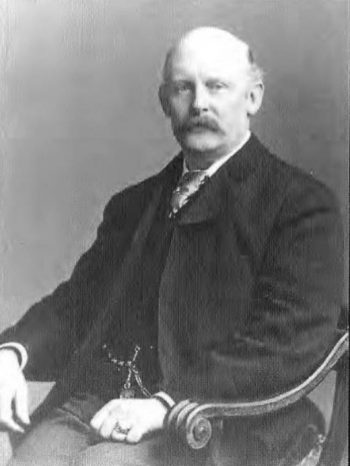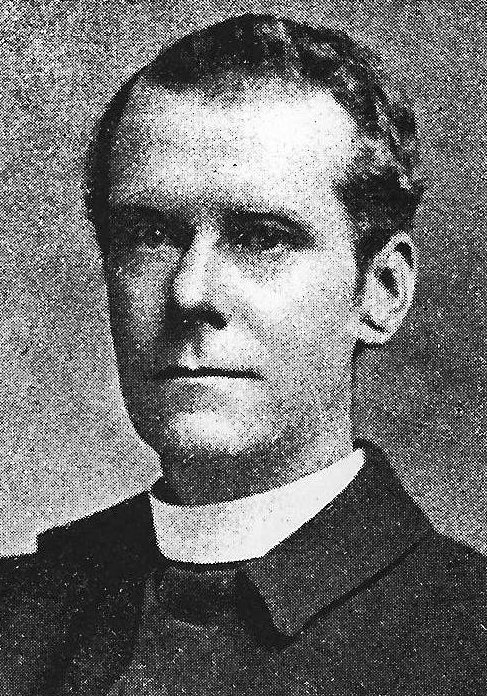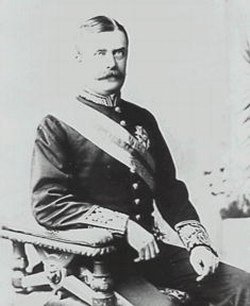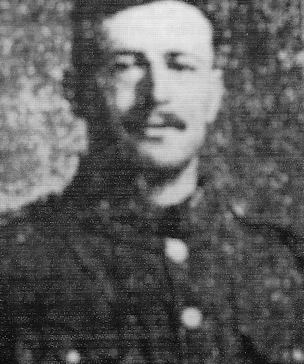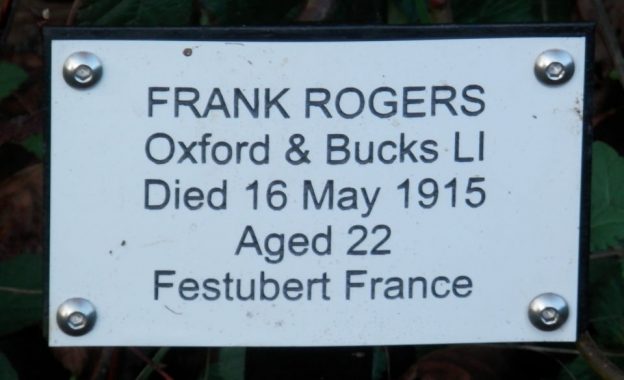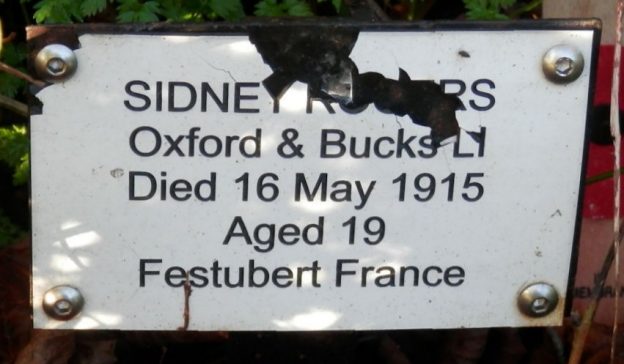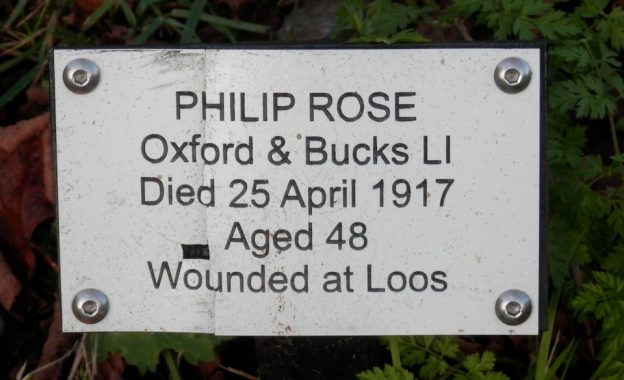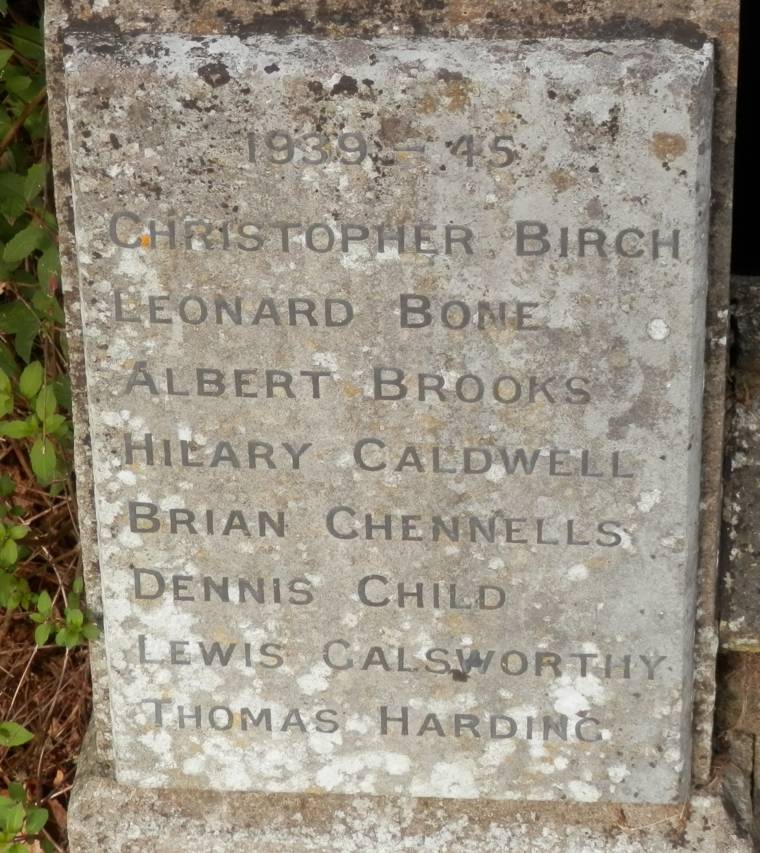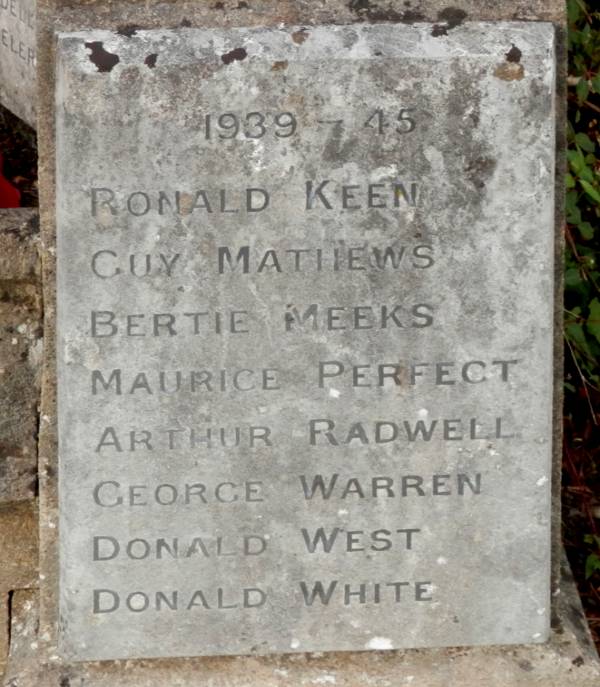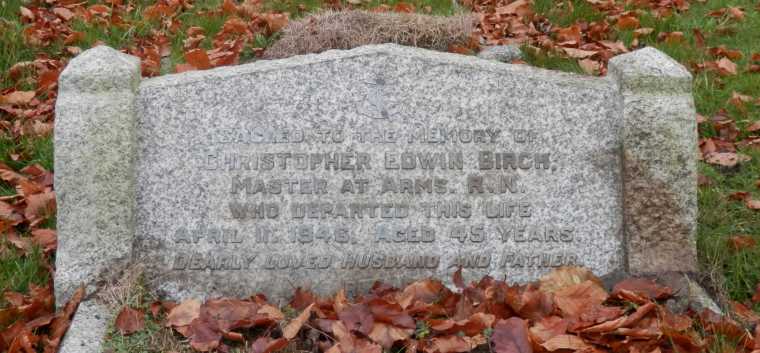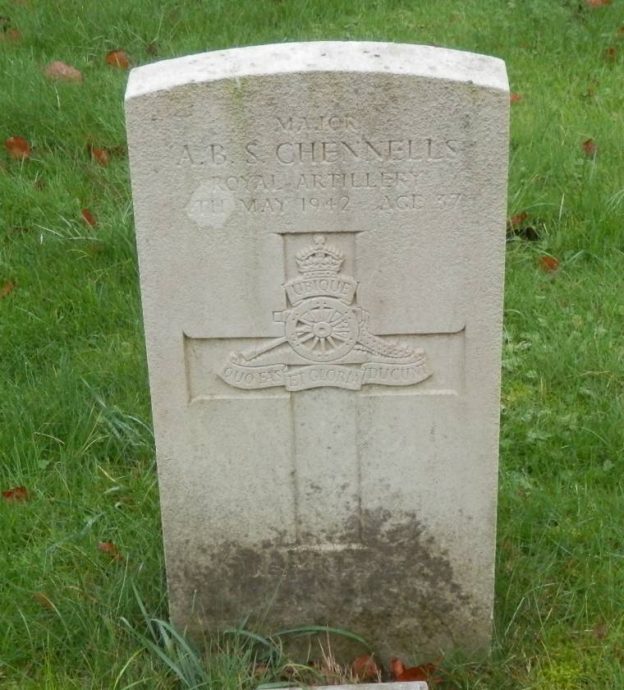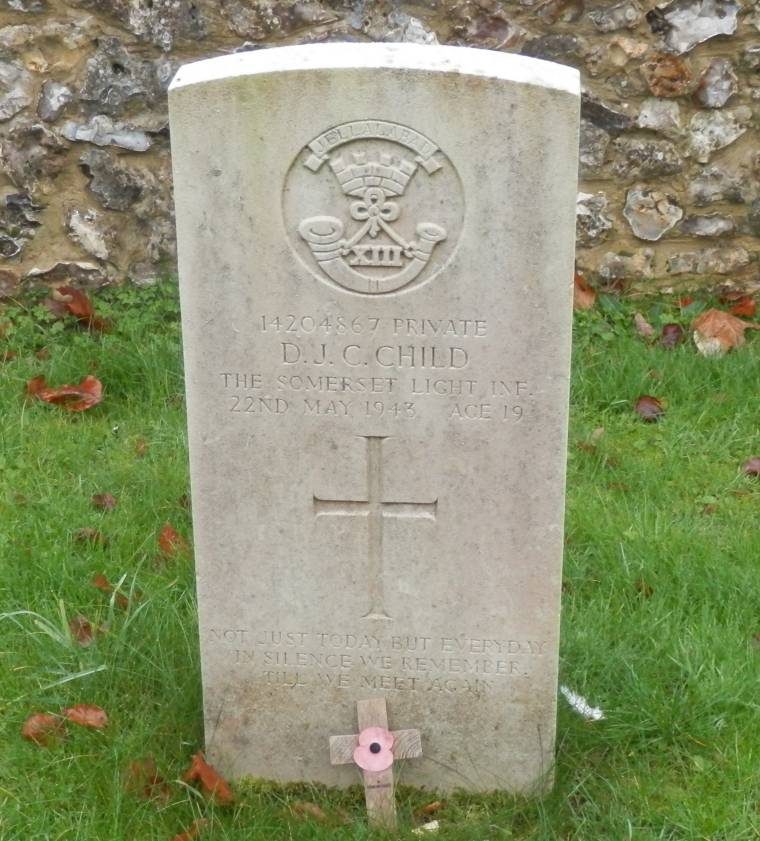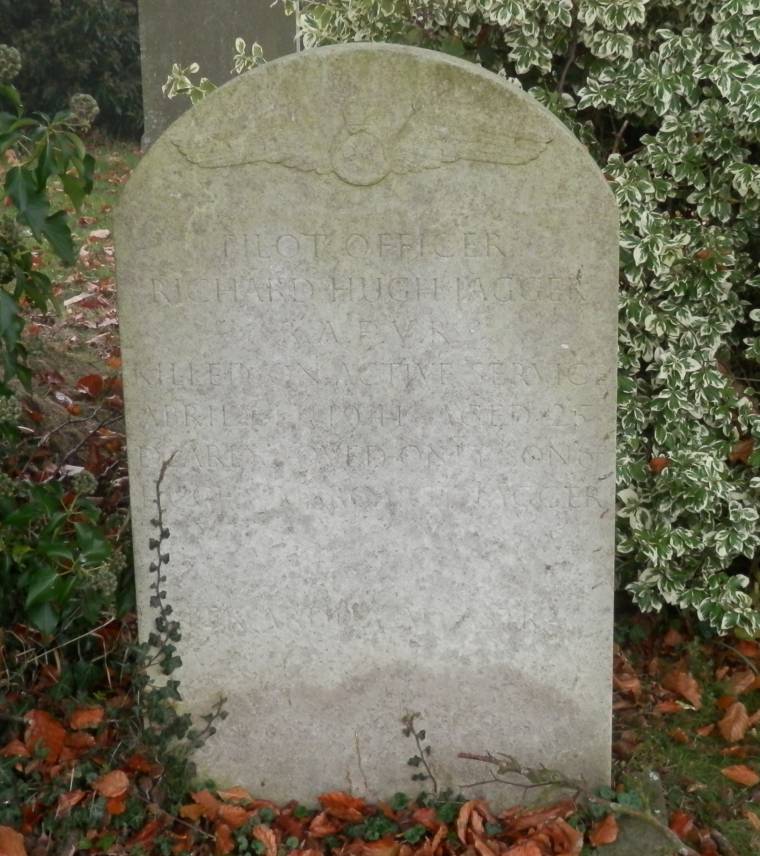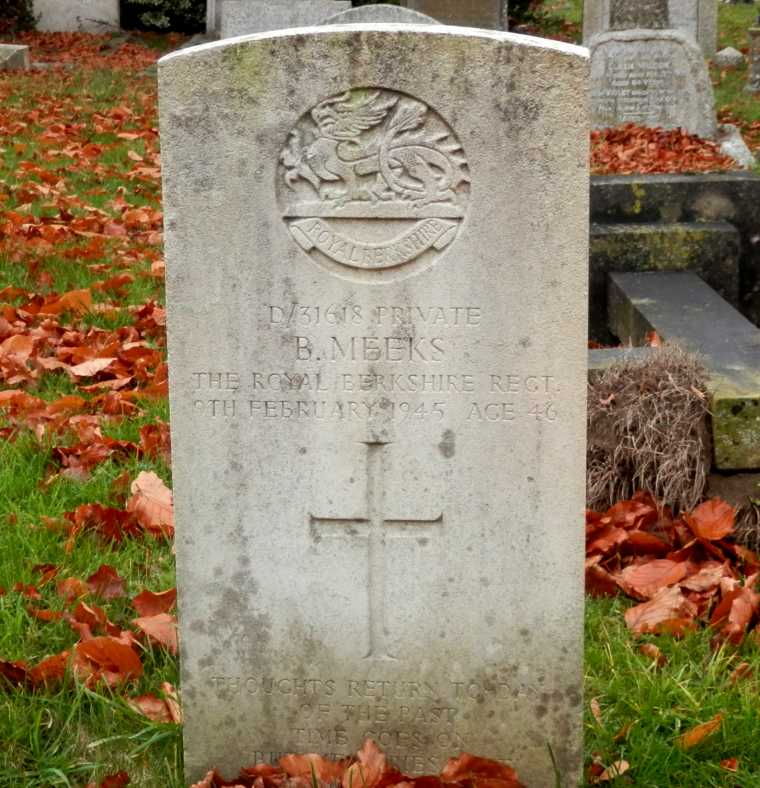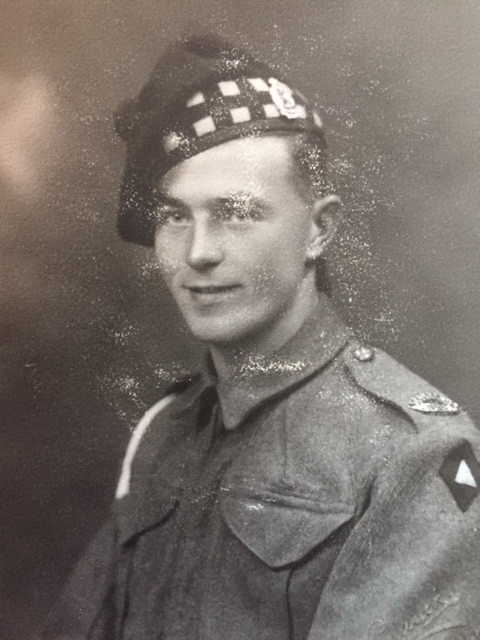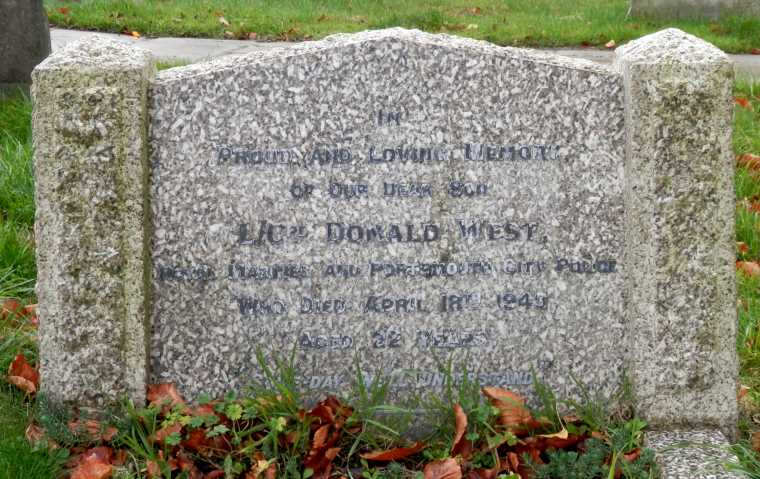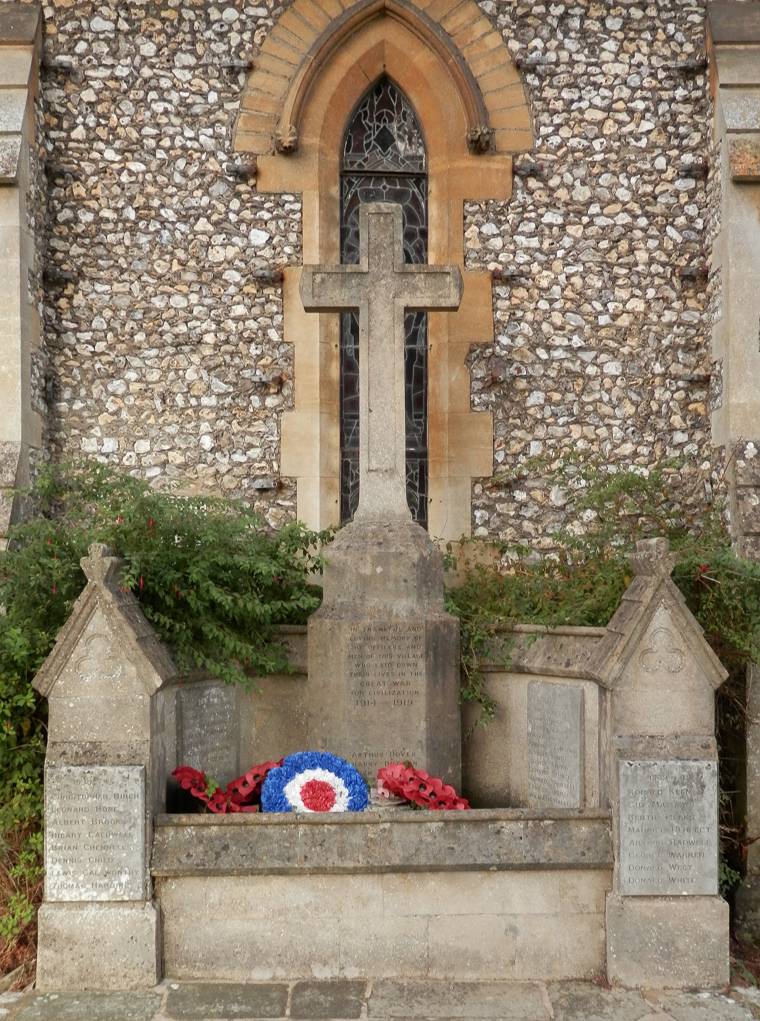
The war memorial gothic cross stands adjacent to St. Margaret’s Church in the churchyard facing Hammersley Lane. There are also 30 memorial trees with an information board on the Back Common describing them all.
The memorial is constructed of Portland Stone. The names are carved and lead filled on plaques on the wall behind the memorial. Three additional names were added at the base of the cross. Richard Martin was identified recently, and his name is missing from the memorial plaques and trees.
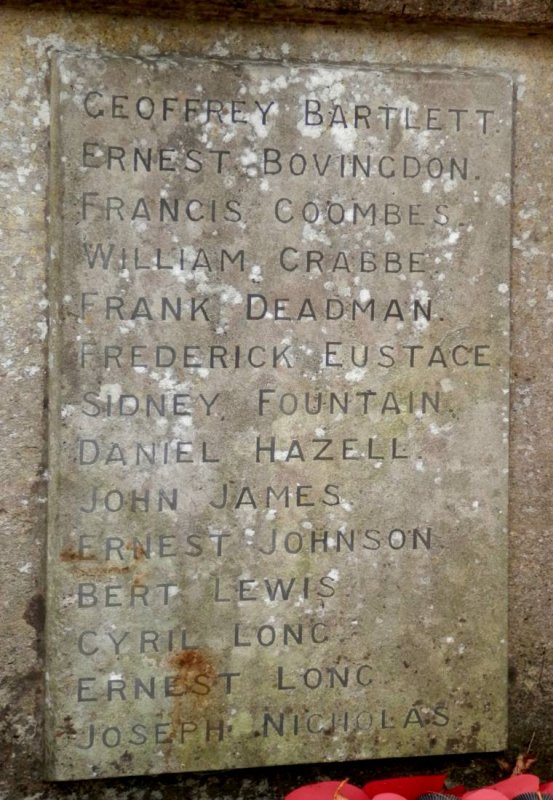
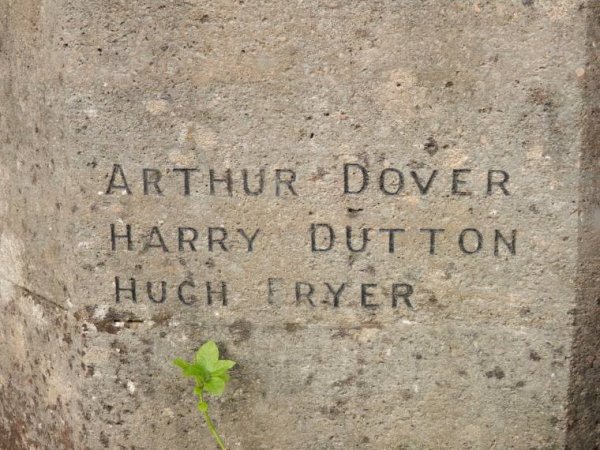
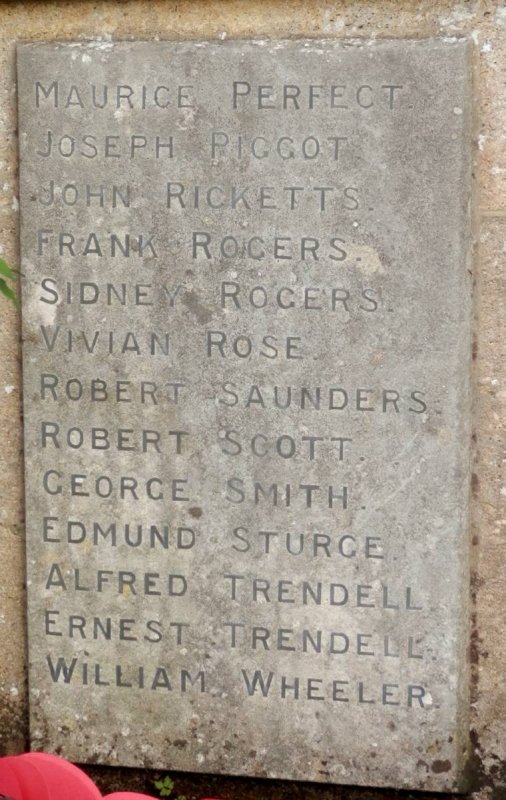
The memorial was built by E. Harris, and on 26th August 1920 was dedicated by the Rt. Rev John Taylor-Smith, Chaplain General of Forces and unveiled by the Lord Lieutenant of Buckingham, Sir Charles Robert Wynn-Carington, 1st Marquess of Lincolnshire, of Wycombe Abbey, whose own son, Viscount Wendover, had died in 1915 from wounds received at the 2nd Battle of Ypres.
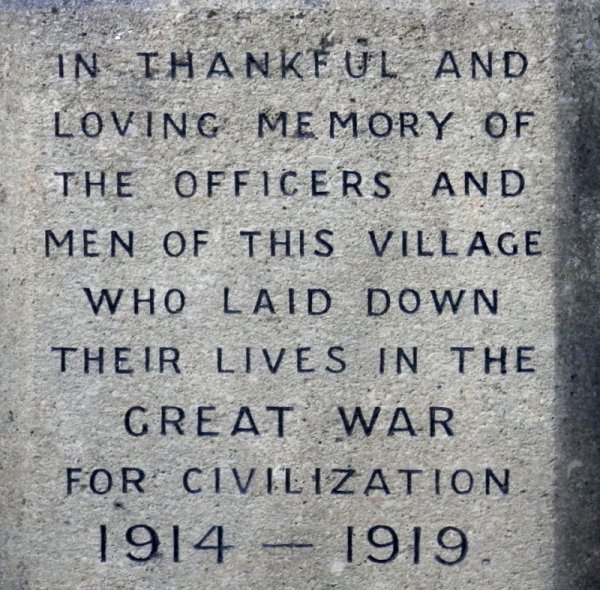 On the cross is the inscription: “In thankful and loving memory of the Officers and Men of this village who laid down their lives in the Great War for civilization. 1914 – 1919.”
On the cross is the inscription: “In thankful and loving memory of the Officers and Men of this village who laid down their lives in the Great War for civilization. 1914 – 1919.”
In February 2008 the War Memorials Trust provided a grant of £360 towards the re-incising and re-painting of letters on the cross. The memorial was not cleaned as the stone had weathered to match the church behind and the community sought to retain this.
Text adapted from War Memorials Trust website.
The Tylers Green Memorial Trees on the Common
Thirty Lime, Beech and Copper Beech trees were planted in 1937 on the Front and Back Commons to commemorate the 30 men from Tylers Green who died in WW1.
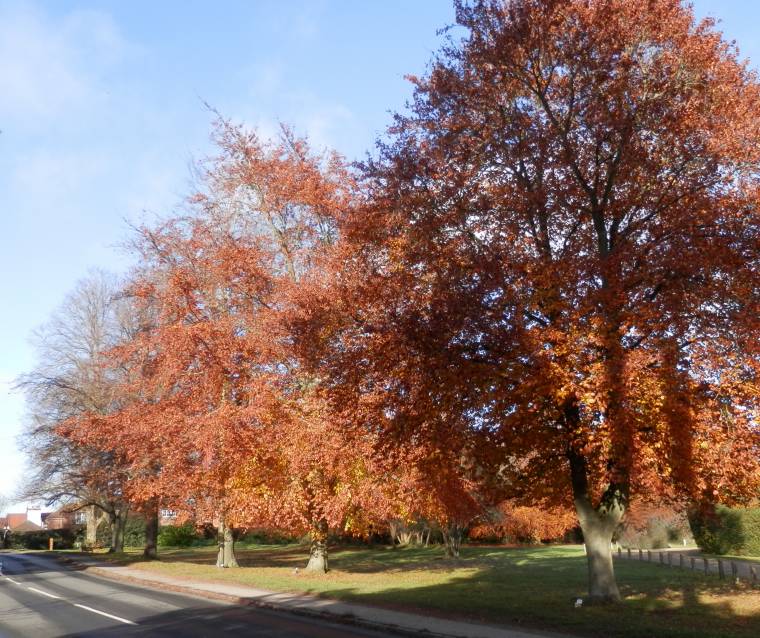
A view of six of the Memorial trees on the Back Common. L-R: Ernest Trendall, William Wheeler, William Crabbe, Edmund Sturge, George Smith, Francis Coombes.
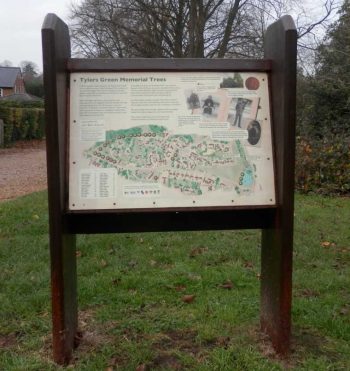
Memorial Trees Information Board.
Located near the Back Common car park,
down the lane opposite Tylers Green Village Hall.
Numbered Plan of the 30 Memorial Trees
(2Mb PDF file, opens in new window)
Zoom/Enlarge the image in your PDF file viewer
to read the tree numbers.
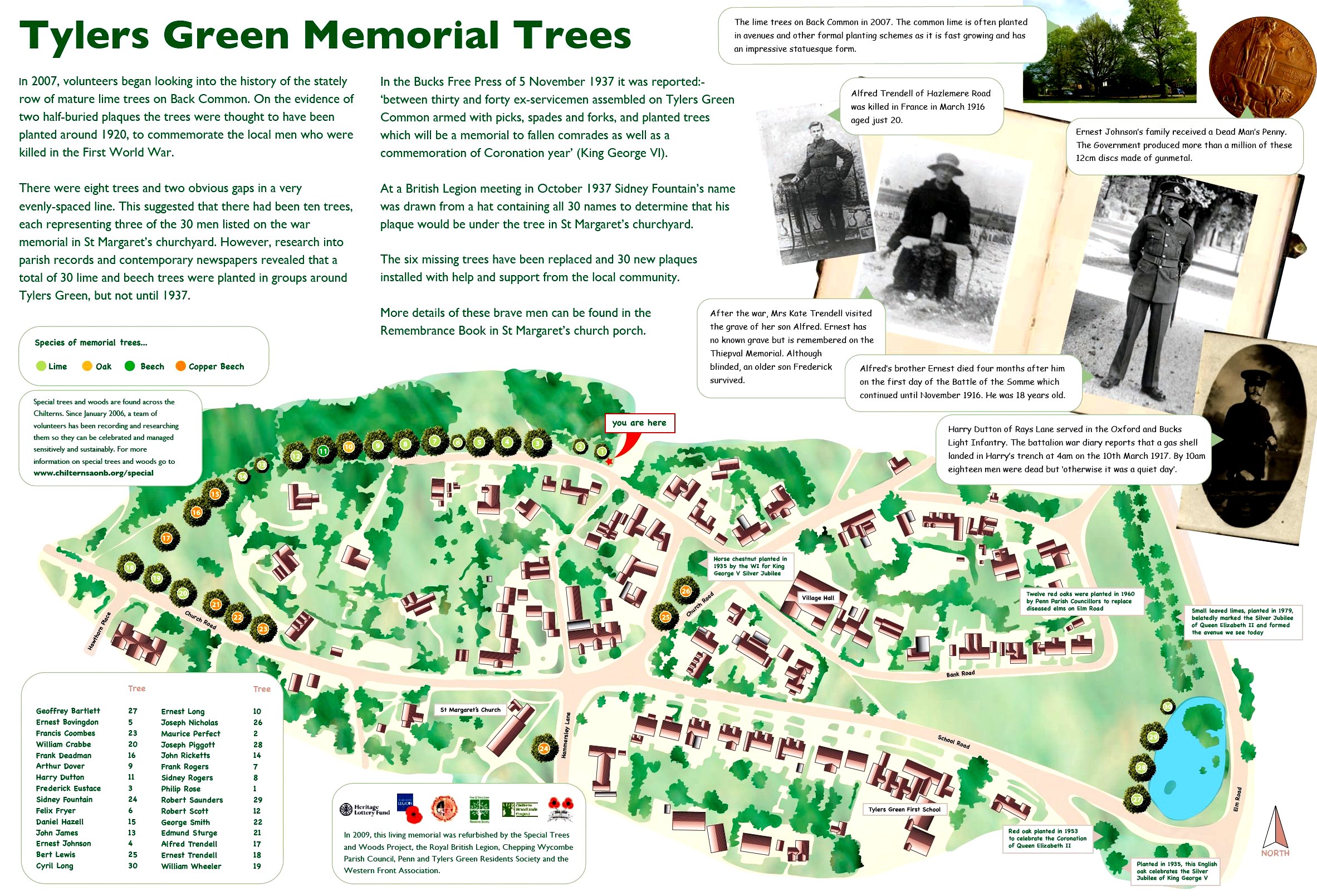
There is an interesting and very comprehensive ‘long read’ on Forces.net about the memorial trees and the men named on them.
The following men are remembered on the St. Margaret’s,
Tylers Green, WW1 War Memorial and Memorial Trees.
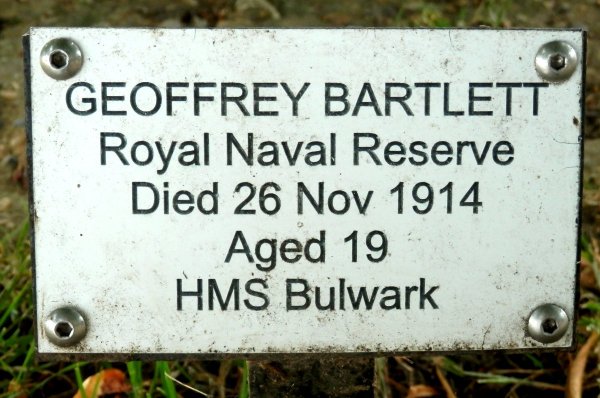
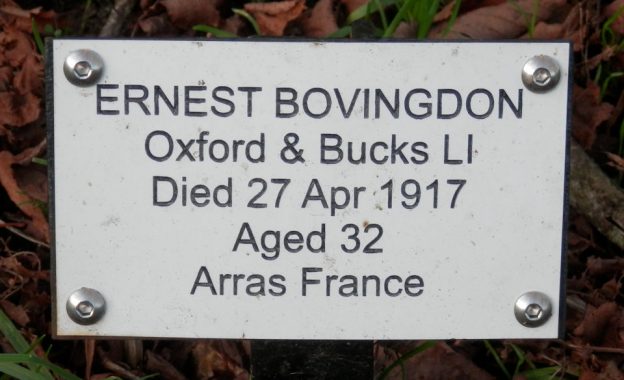
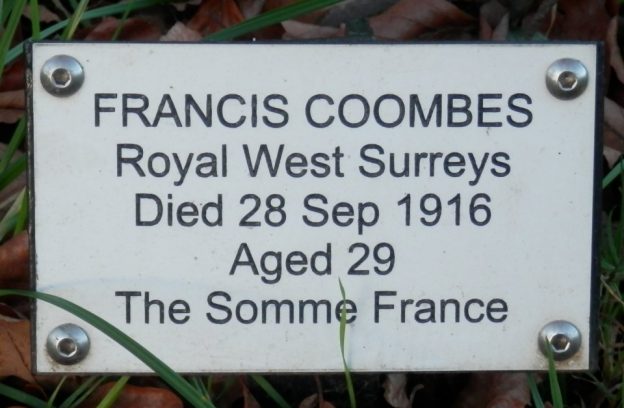
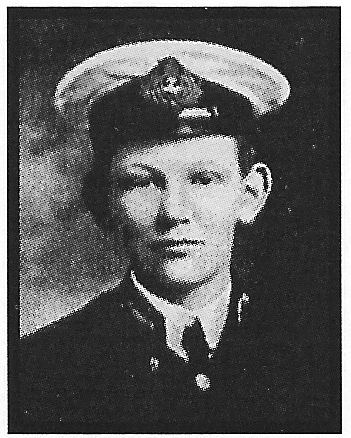 Geoffrey Edward Rose BARTLETT, Midshipman,
Geoffrey Edward Rose BARTLETT, Midshipman,
Royal Naval Reserve HMS Bulwark, Age 19,
Died 26 Nov 1914, as a result of a large explosion
on HMS Bulwark, whilst loading ammunition.
Buried: Portsmouth Naval Memorial, Hants, Refce. 6
Born: c1895, S Kensington, London.
Parents: Edward Noel Napier Bartlett J.P.
& Dorothy Bartlett, née Rose,
second daughter of Sir Philip Rose of Rayners.
4 Tenby Mansions, Nottingham St, London, W1,
late of St Margaret’s Cottage, School Road, Tylers Green.
Geoffrey Bartlett seems to have come from a naval family, being the great-great-grandson of Admiral James Noble, who served with Commodore Horatio Nelson, later Vice Admiral Horatio Nelson.
Ernest BOVINGDON, Private 266694,
Oxford & Bucks Light Infantry, 5th (Service) Battalion.
Age 32, Date of death 27 Apr 1917, Killed in action during Arras Offensive.
No known grave. Arras Memorial, Pas de Calais, France, Bay 6 & 7
Born: 1884, one of 8 children, at Winchmore Hill,
Landscape gardener, fencing contractor.
Parents: William Timothy Bovingdon, (late) chair maker,
& Ellen Bovingdon née Jordan. Woodbine Cottages, Bank Road, Tylers Green.
Wife: Lily Hearne, 1913, Died 1915 with their infant son.
Younger brother of Frank Bovingdon (Chalfont St Giles War Memorial)
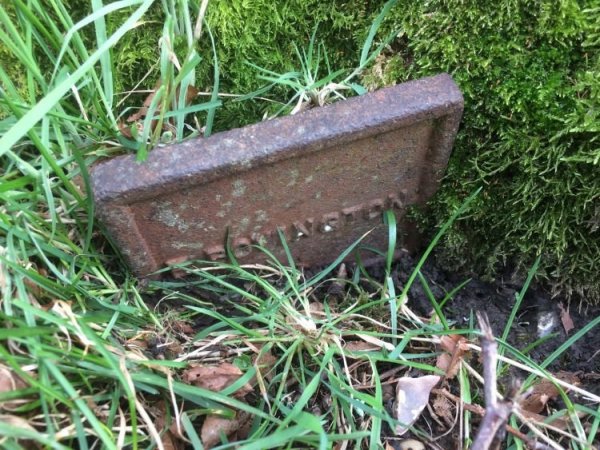
Ernest Bovingdon’s original 1937 plaque, mis-spelt as ‘Bovington’.
© Greg Allwood, Forces.net
Francis COOMBES, Private, G/8231, The Queens (Royal West Surrey Regiment).
Age 30, died 28 Sep 1916. Killed by sniper fire: Thiepval, France & Flanders
Cemetery Thiepval Memorial, Somme, France, Pier & Face 5D & 6D
Born: c1886, Tyler’s Green, Builder’s Clerk, Golders Green.
Parents: Charles Coombes, agricultural labourer, & Mary A Coombes, née Perkins, Sunny Bank, Kingswood Rd, Tyler’s Green
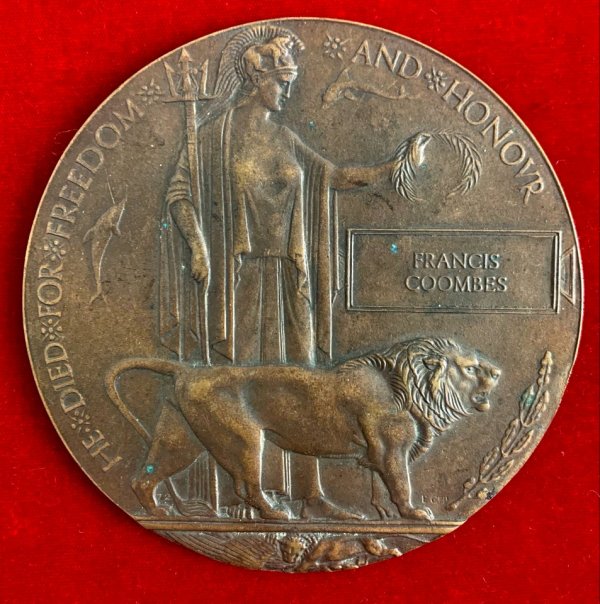
Francis Coombe’s Next of Kin Memorial Plaque. Approximately 11 cms or 4½ inches diameter. Often call ‘Dead Man’s Pennies’
This plaque may be for sale Contact Us and we will forward your details.
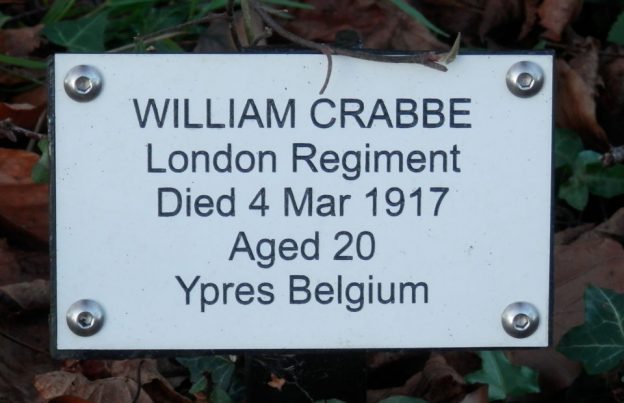 William CRABBE, Private, 632176, London Regiment, 20th Battalion
William CRABBE, Private, 632176, London Regiment, 20th Battalion
Age 20, Died: 4 March 1917, Died of wounds, France.
Cemetery Lijssenthoek Military Cemetery, Poperinge, Belgium, XI.B.18A
Born 2nd November 1896, Edmonton Workhouse, Enfield, Middx.
Pre-war occupation, worked for local butcher Mr. R.H. Moreton.
William’s birth certificate shows that he was born at Edmonton Workhouse to Emily Crabb, a single parent. William was adopted from Dr. Barnardos by Mary Randall (née Adams) and her husband Jesse.

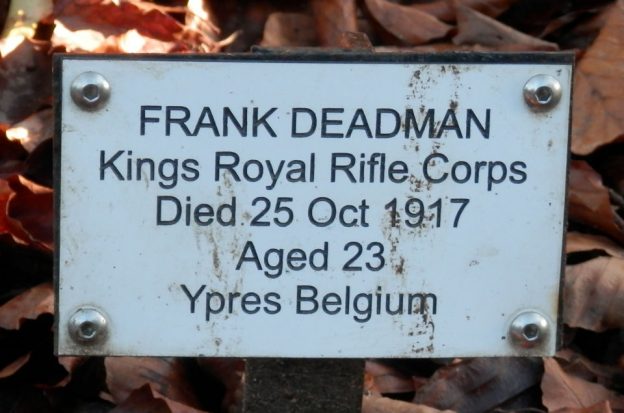 Frank DEADMAN, Rifleman C/1548,
Frank DEADMAN, Rifleman C/1548,
Kings Royal Rifle Corps, 16th Battalion.
Enlisted: High Wycombe, Sept. 1915.
Died of wounds: 25 Oct 1917, Age:24:
2nd Australian General Hospital, Wimereux, Nr Boulogne.
Buried: Wimereux Communal Cemetery, Pas de Calais, France, VI.E.26
Born: c1893. Thornton Heath, Surrey,
Pre-war Occupation: Gardener for Sir Philip Rose, Rayners, Penn..
Parents: George Deadman, head gardener, & Ada S Deadman, née Herridge,
Cowbridge, Malmesbury, Wilts.
Named on Malmesbury and Tylers Green memorials.
Obituary: North Wilts Herald, 2nd November 1917.
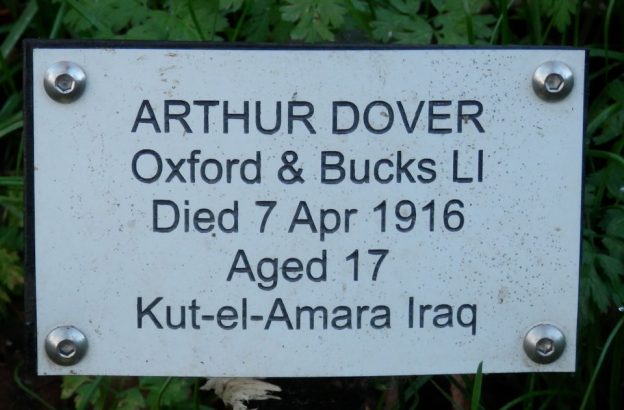
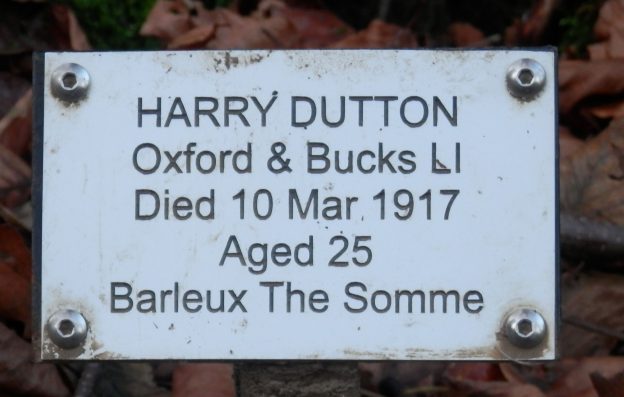
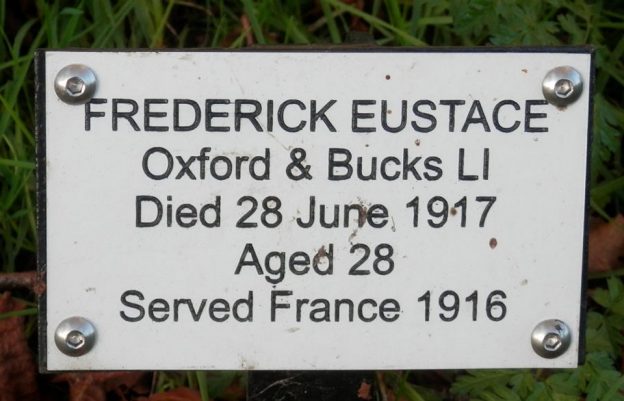
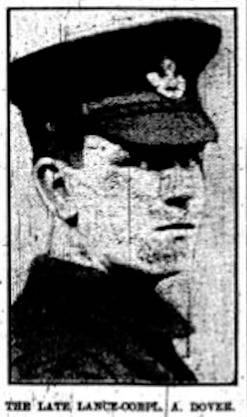 Arthur DOVER, Lance Corporal, 17480, Oxford & Bucks Light Infantry, 1st Battalion
Arthur DOVER, Lance Corporal, 17480, Oxford & Bucks Light Infantry, 1st Battalion
Age: 17. Died of wounds: 7 April 1916, Persian Gulf
Amara War Cemetery, Iraq, XXII.C.15
Born: 1898, Tylers Green, Parents: Henry Dover, chair maker, & Kate (late) Dover née Perfect, Tyler’s Green
Notes: Arthur was a Cornet player, Penn & TG Brass band & Penn Orchestra.
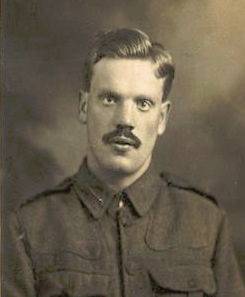
Harry James DUTTON, Private 265063, Oxford & Bucks Light Infantry, 1/1st Bucks Battalion.
Age: 25, Died 10 March 1917, Killed in action France,
Hem Farm Military Cemetery, Hem-Monacu, Somme,
France, II.L.16. Pre-war occupation: gardener.
Parents: George Dutton , baker, & Elsie Mary Dutton, née Free, Ferndale Cottage, Rays lane, Tylers Green.
Wife: (married 1915) Elsie Dutton née Rogers,
Brook Street, High Wycombe.
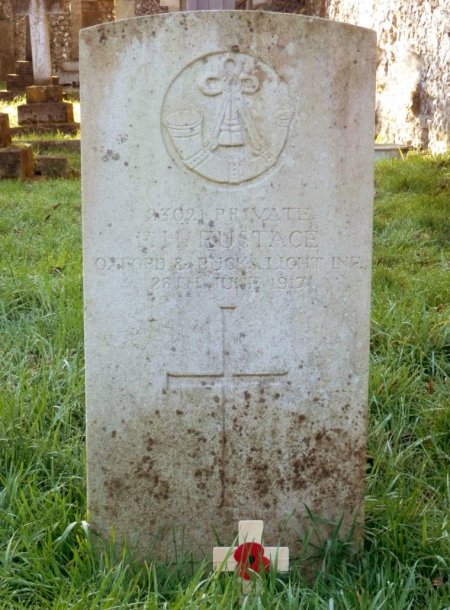 Frederick Harwood EUSTACE, Private, 23021,
Frederick Harwood EUSTACE, Private, 23021,
Oxford & Bucks Light Infantry, 3rd Reserve Battalion.
Age: 27, Died of severe epilepsy, 28 June 1917
at Cosham Military Hospital, Hants.
Buried: St. Margaret’s, close to north boundary.
Former pupil of Tylers Green School.
Pre-war occupation: butcher.
Parents: John Eustace, chair turner,
& Lydia E Eustace née Putnam, Barnes Lane, Hazlemere.
Wife: Grace Woodhouse (Md. 1913), Hope Cottage, Tylers Green.
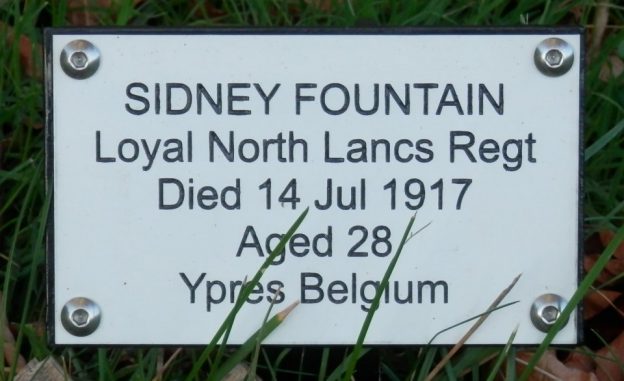
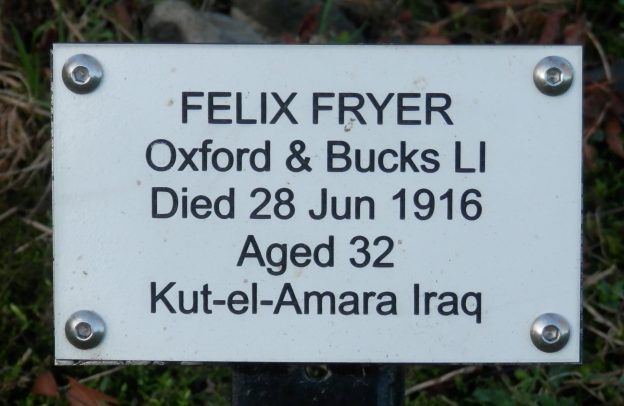
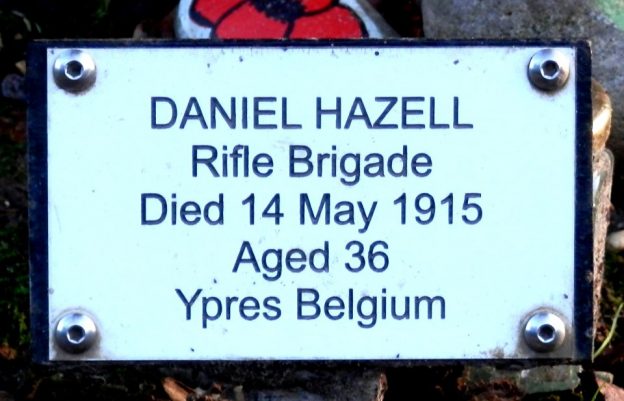
Sidney Arthur FOUNTAIN, Private, 33828,
Regiment Loyal North Lancashire Regiment 10th Battalion.
Age: 28, Died of wounds, 11 July 1917, Boulogne.
Boulogne Eastern Cemetery, Pas de Calais, France, IV.A.31.
Born c1889, Tyler’s Green, Baptism 28 April 1889.
Parents William Fountain, chair maker,
& Ellen Fountain, The Hollies, Tyler’s Green.
Sidney Fountain played Cricket & Football for Tylers Green,
played in the brass band and at St. Margaret’s.
His name was drawn from a hat to be commemorated on
the memorial tree in St. Margaret’s front churchyard.
(Felix) Hugh FRYER, Private 9014, Oxford & Bucks Light Infantry, 1st Battalion.
Age: 32, Died in captivity, 28 June 1916, Persian Gulf, Basra Memorial, Iraq, Panel 26 & 63. Pre-war occupation: bricklayers labourer/regular soldier.
Parents: John Fryer, chair maker & Lizzie Fryer, née Perfect, Potters Cross, Tylers Green. Notes: Served in India
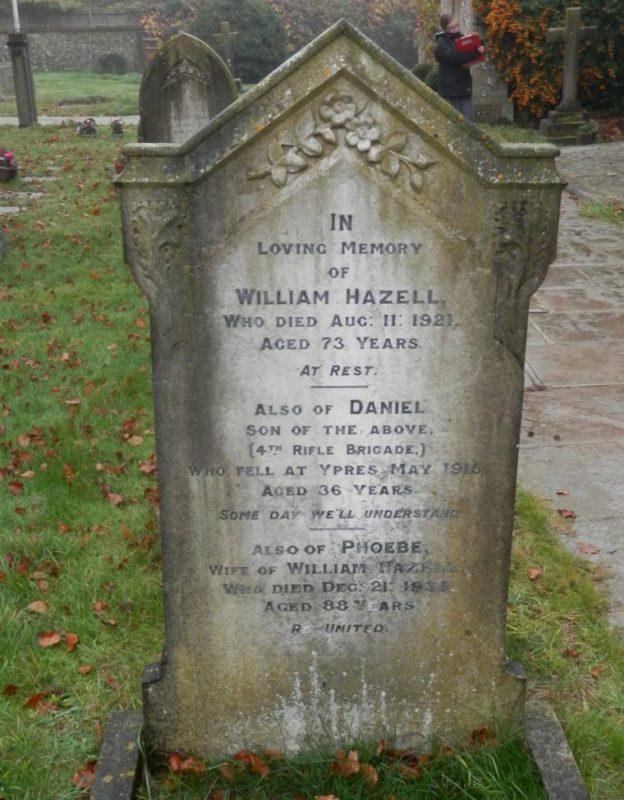
Daniel HAZELL, Rifleman, 8113,
Regiment Rifle Brigade, 4th Battalion.
Died: 14 May 1915, Age 36, Killed in action Ypres.
No known grave, Ypres (Menin Gate) Memorial, Ieper,
Belgium, 46-48 & 50.
Parents: William Hazell, shoe maker, & Phoebe Hazell,
Hammersley Lane, Tyler’s Green.
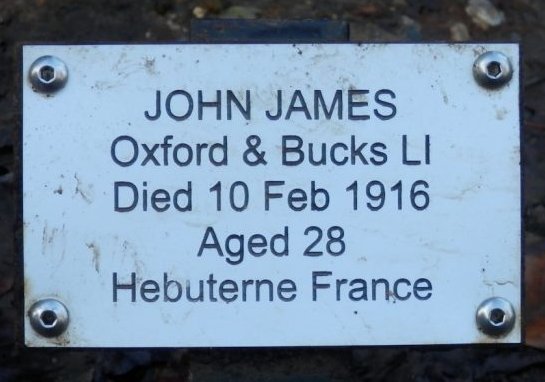
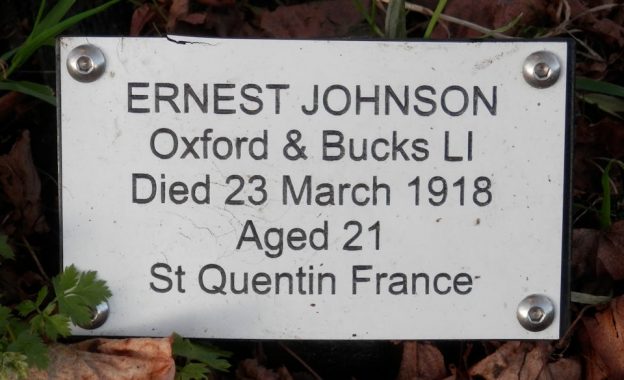
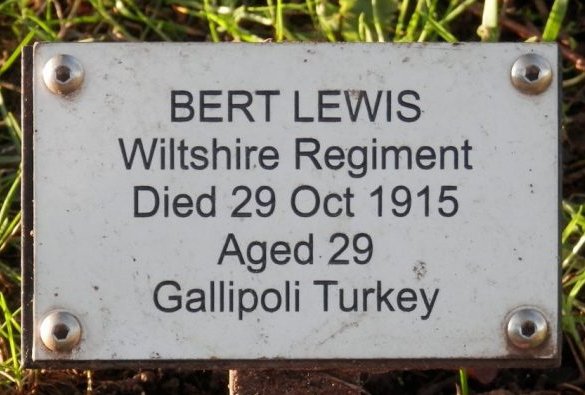
John Joseph JAMES, Private, 1615,
Oxford & Bucks Light Infantry, 1/1st Bucks Battalion
Age:27, Died: 27 10 February 1916, Killed in action France & Flanders
Hebuterne Military Cemetery, Pas de Calais, France, I.A.3
Born: c1889, Henley on Thames, Oxon.
Pre-war occupation: paper makers labourer .
Parents: Joseph James, (late), turner, & Sarah James.
Range View, Wycombe Marsh .
Wife: Fanny James nee Kent, Abbey Barn Road, Wycombe Marsh.
CWGC gives initials as J T James.
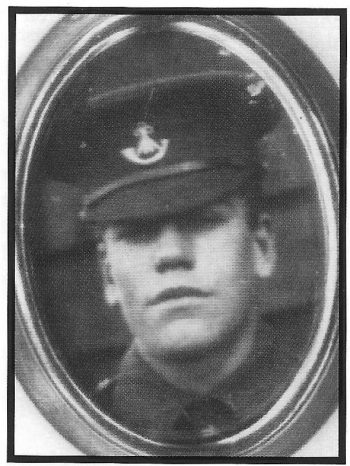 Ernest Harry JOHNSON, Corporal, 21344,
Ernest Harry JOHNSON, Corporal, 21344,
Oxford & Bucks Light Infantry, 5th Battalion.
Age: 21, Died: 23 March 1918, Killed in action France, No Known Grave. Pozieres Memorial, Somme, France, Panel 50 & 51.
Born: c1897 Tyler’s Green.
Pre-war occupation, gardener.
Parents: James Henry Johnson, bricklayer,
& Ada Johnson, née Goddard, Nursery Lane, Tyler’s Green
Bert Harry LEWIS, Lance Corporal, 18338,
Wiltshire Regiment 5th Battalion.
Age: –, Died: 29 October 1915, of wounds Gallipoli.
Hill 10 Cemetery, Turkey, I.E.10. Born: c1886 Hazlemere,
Pre-war occupation: chair upholsterer.
Parents: George Lewis, carpenter, & Selina Lewis,
Woodbine Cottages, Bank Road, Tylers Green .
Wife: Esther Lewis nee Collins, (1907), St Johns, Hazlemere.
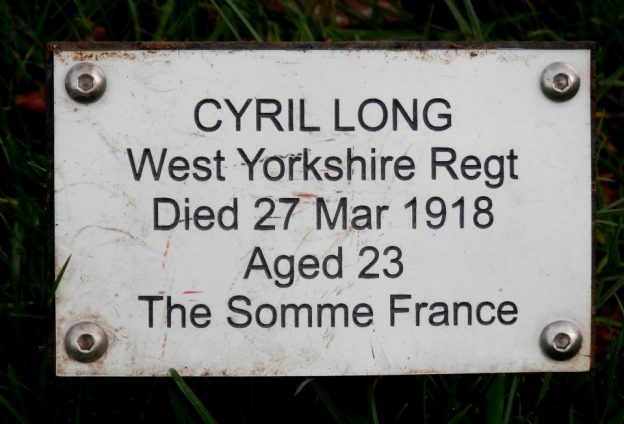
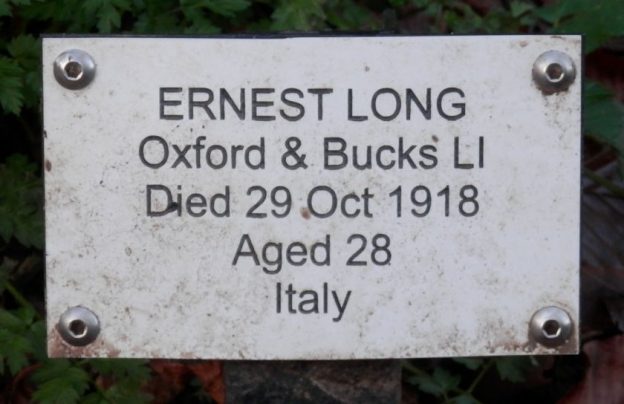
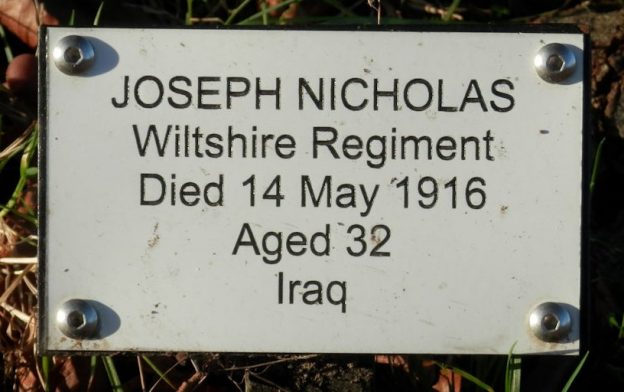
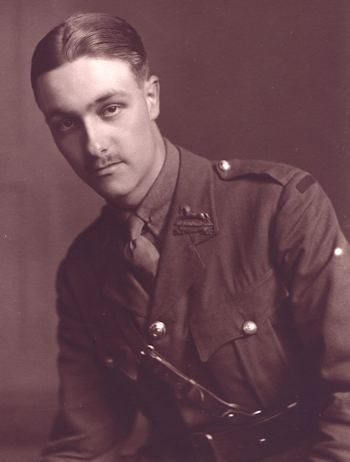 Cyril Edwin Arnold LONG, Captain, W Yorkshire Reg’t,
Cyril Edwin Arnold LONG, Captain, W Yorkshire Reg’t,
(Prince of Wales Own), 15th Battalion [Leeds Pals].
Formerly Honourable Artillery Company, Acting Sergeant 2782. Commissioned 27 Dec 1915.
Died: 27 March 1918, Age 23, Killed in action.
Douchy-les-Ayette British Cemetery, Pas de Calais, France, IV.F.12
Born: 3 October 1895, Walthamstow, Essex,
Attended Royal Grammar School,
also named on RGS War Memorial.
Pre-war ocupation: apprentice chemist
Parents: Stephen George Long, school master, & Emily Long,
School House, School Road, Tyler’s Green
Ernest David LONG, Sergeant, 265784,
Oxford & Bucks Light Infantry, 1/1st Bucks Battalion.
Age: 29 Died: 29 October 1918, Killed in action Italy.
Barenthal Military Cemetery, Italy, Plot 2 Row A Grave 1.
Born: c1889 Wycombe, Baptism: 15 January 1890,
Woodbine Cottages, Bank Road, Tylers Green.
Pre-war occupation: gardener.
Parents: late David Long, coal carman, & Emily Long,
Woodbine Cottages, Tylers Green.
Richard Mitchell MARTIN, Gunner, 163616, Royal Field Artillery
C Battery, 317th Brigade. Military Medal.
Age 30, Died 2 October 1918, France.
Ribecourt Road Cemetery, 1.A.5, Trescault, France.
Born 19th March 1888, orphaned age 10, Market Porter.
Husband of Florence Catherine (née Randall) Dean (formerly Martin),
of 2, Cherry Tree Cottage, Tyler’s Green, High Wycombe, Bucks.
Born at Poplar, London.
Named on High Wycombe Hospital War Memorial,
Richard Martin is not named on the Tylers Green War memorial, no memorial tree or plaque.
Joseph NICHOLAS, Private, 20834, Wiltshire Regiment 5th Battalion..
Age: 32, Died: 14 May 1916, Mesopotamia. Amara War Cemetery, Iraq, XXI.H.10.
Born: c1884 Devizes, Occupation 1901: furniture porter.
Parents: late William Nicholas, agricultural labourer, & Susan Nicholas,
Folly Rd, Roundway, Devizes, Wilts.
Joseph Nicholas’ wartime will (opens in new tab).
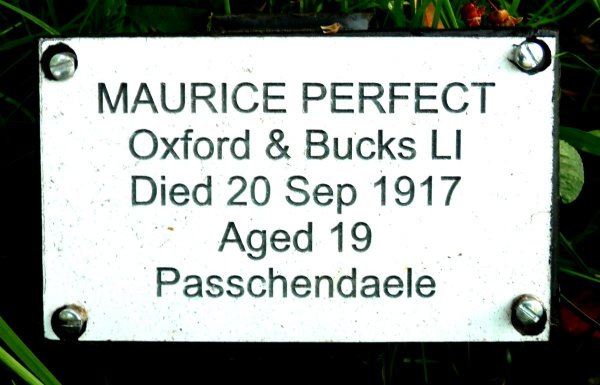
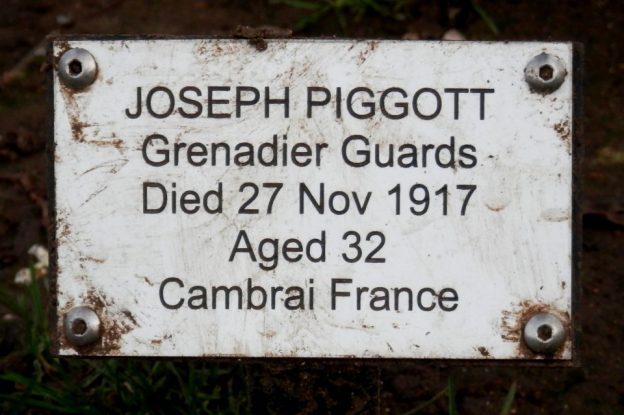
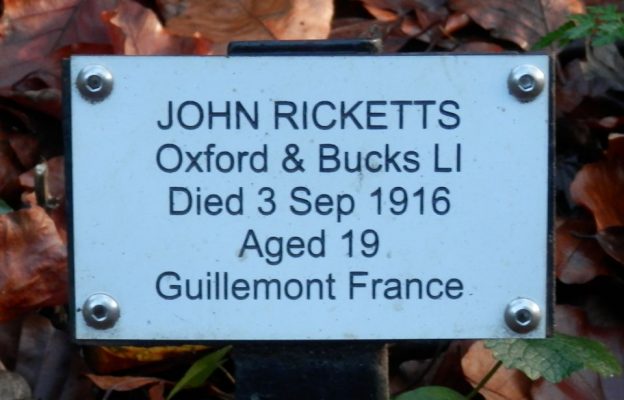
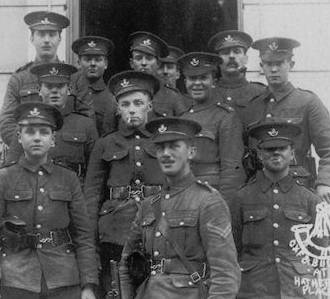
Centre with cigarette.
Maurice PERFECT, Private, 202749,
Oxford & Bucks Light Infantry, 6th Battalion.
Born: c1897 Penn, Died: 20 Sep 1917, Age 19,
Killed in action, Passchendale, no known grave.
Tyne Cot Memorial, Zonnebeke, West-Vlaanderen,
Belgium, Panel 96 to 98
Parents: Frederick Perfect, game keeper at Rayners,
& Lucy, née Beal, Rayners Cottage, Beacon Hill, Penn.
Joseph PIGGOTT, Private, 24846, Grenadier Guards, 3rd Battalion.
Age: 32, Died: 27 November 1917, Killed in action France, no known grave.
Cambrai Memorial, Louverval, Nord, France, Panel 2
Born: c1885, Potton, Beds, Pre-war occupation: bricklayer.
Parents: Reuben (late) Piggott, fellmonger, & Mary J Piggott,
Greenhurst, Elm Road, Tyler’s Green.
Note: ‘fellmonger’, dealer in hides and skins, Especially. sheep skins.
John Henry RICKETTS, Private, 21346,
Oxford & Bucks Light Infantry, 6th Battalion.
Age: 19, Died: 03 September 1916, Killed in action France & Flanders.
Guillemont Road Cemetery, Guillemont, Somme, France, VI.O.6
Born: c1897, Turners [Tylers] Green, Baptism: 5 September 1897, Tylers Green.
Pre-war occupation apprentice upholsterer, Randalls, High Wycombe.
Parents: Henry Ricketts, bricklayer, & Annie Saunders, Tylers Green.
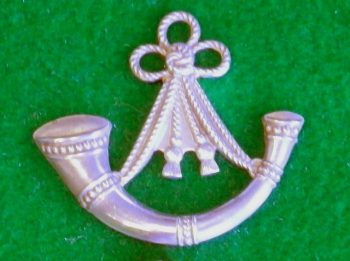
Oxford & Bucks Light Infantry, Cap Badge
Badge Courtesy Ron Coltas.
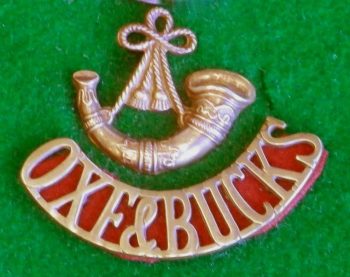
Oxford & Bucks Light Infantry, Shoulder Badge
Badge Courtesy Ron Coltas.
Frank ROGERS, Private, 9966, Oxford & Bucks Light Infantry, 2nd Battalion.
Age: 22, Died: 16 May 1915, Killed in action France, no known grave.
Le Touret Memorial, Pas de Calais, France, Panel 26.
Born: c1893 Winchmore Hill.
Parents: George Rogers (dd, 1890), pot hawker, & Mary Ann née Hazell,
Tyler’s Green. Note: Died with his brother Sidney Rogers.
Sidney ROGERS, Private, 8332, Oxford & Bucks Light Infantry, 2nd Battalion
Age: 19, Died: 16 May 1915, Killed in action France & Flanders
Le Touret Memorial, Pas de Calais, France, Panel 26.
Born: c1896, Penn or Amersham,
Parents: George Rogers (late), pot hawker, & Mary Ann née Hazell,
Tyler’s Green. Note: Died with his brother Frank Rogers.
(Philip) Vivian ROSE, Captain, Oxford & Bucks Light Infantry, 7th Battalion.
Age: 48, Died: 25 Apr 1917, Taken Prisoner of War, Died Military Orthopaedic Hospital, Shepherd Bush, of wounds received at Loos, 26th September 1915.
Grave & Memorial: Family vault, outside West end of St. Margaret’s church.
Born: 25 Mar 1869, South Kensington, London. Pre-war occupation: Solicitor.
Parents: Sir Philip & Lady A Rose, Solicitor, Rayners, Penn.
Wife: Maud Winifred Rose née Gillian, Md. 1899, 5 Roland Gardens, S Kensington.
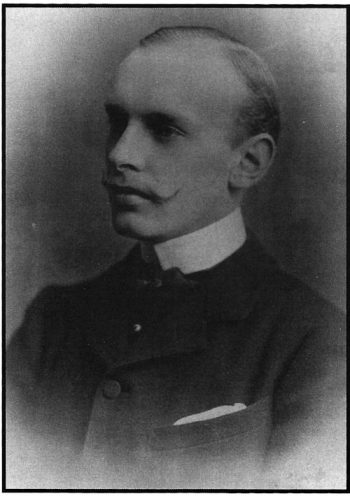
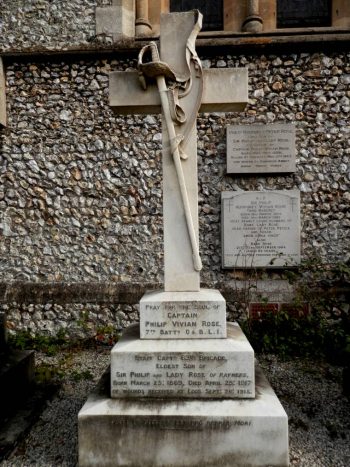
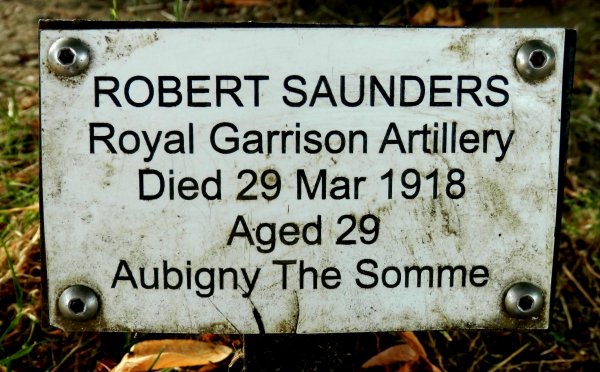
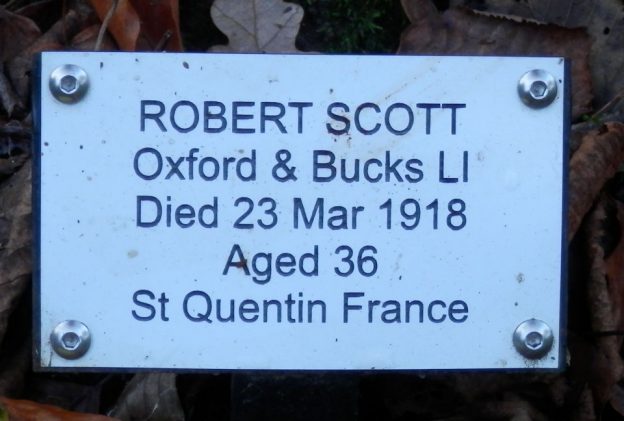
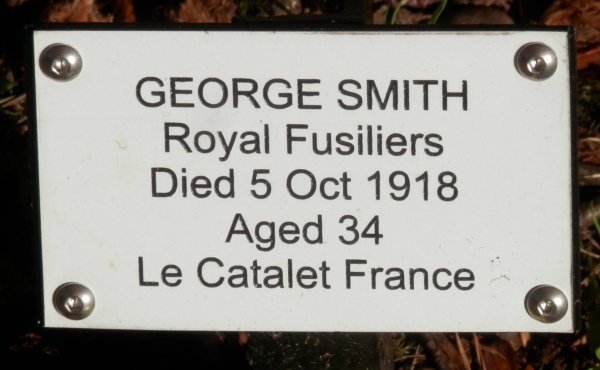
Robert William SAUNDERS, MSM, Sergeant, 26645,
(Meritorious Service Medal, posthumous).
Royal Garrison Artillery, 60th Siege Battery
Age: 29, Died: 29 Mar 1918, of wounds France & Flanders.
Aubigny Communal Cemetery Extension, Pas de Calais, France, III.D.30.
Born: c1889 High Wycombe.
Parents: Robert Saunders (late), & Jane née Lacey, Potters Cross, Penn.
Robert SCOTT, Private, 267231, Oxford & Bucks Light Infantry, 5th Battalion.
Age: 36, Died: 23 March 1918, Killed in action France, no known grave.
Pozieres Memorial, Somme, France, Panel 50 & 51.
Born: c1882 Great Marlow.
Pre-war occupation: Postman, at Tylers Green for a time.
Parents: Alfred Scott, wheelwright, & Eliza Scott, Great Kingshill.
Husband of: Alice Scott, 1 Council Cottage, Finchampstead, Wokingham, Berks.
George SMITH, Private, 17497, Royal Fusiliers
(City of London Regiment), 3rd Battalion.
Age: 34, Died: 5 October 1918, of wounds France.
Doingt Communal Cemetery Extension, Somme, France, III.B.22.
Place of birth 1884, Tyler’s Green,
lived with his Grand-mother: Mrs Jane Birch, Tyler’s Green.
Saw action in Egypt and Salonika.
George Smith’s wartime will (opens in new tab).
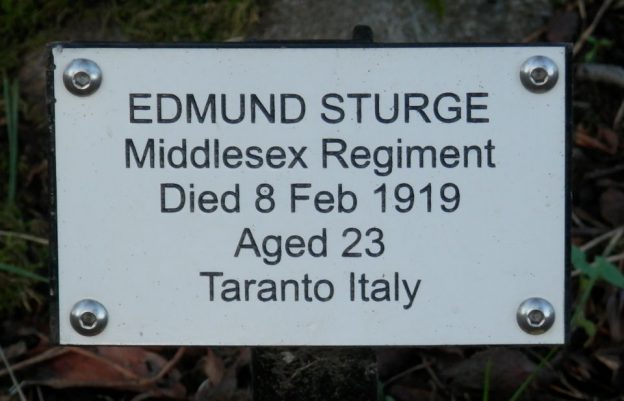
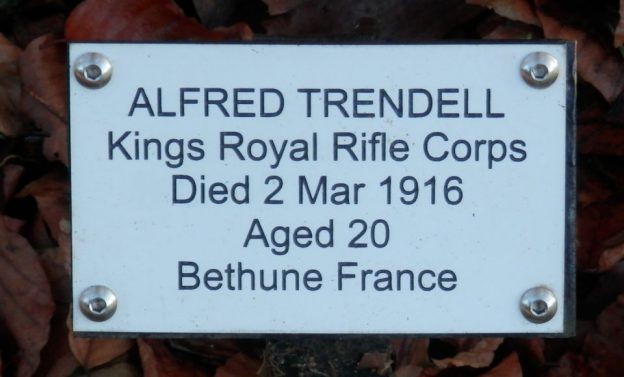
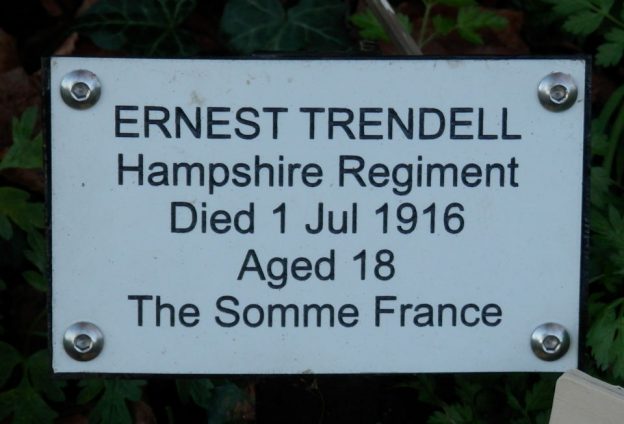
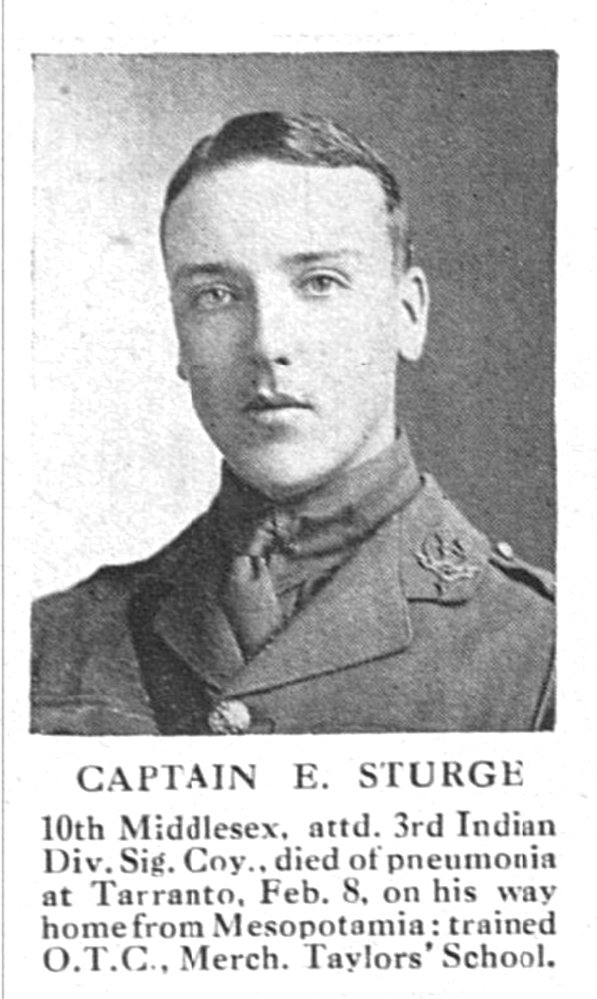 Edmund STURGE, Captain, Middlesex Regiment,
Edmund STURGE, Captain, Middlesex Regiment,
10th Battalion. Attached to: Signal Service
(3rd Lahore Division, Indian Army), Royal Engineers.
Mentioned in despatches.
Age: 23, Died: 8 February 1919.
Taranto Town Cemetery Extension, Italy, I.G.5.
Born: c1896 Paddington, London.
Attended Merchant Taylors School.
Served in India, Mesopotamia and Palestine.
Parents: Henry Havelock Sturge, Surgeon MRCS,
& Maria Sturge. 81 Elgin Avenue, Paddington.
Spent summer holidays at Highfield, New Road, Tylers Green.
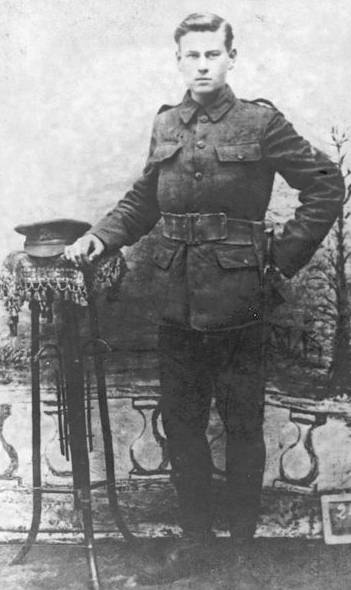 Alfred William TRENDELL, Corporal, 11878,
Alfred William TRENDELL, Corporal, 11878,
Kings Royal Rifle Corps, 1st Battalion.
Age: 20, Died: 2 March 1916, of wounds France.
Aix-Le-Nouvette Communal Cemetery Extension,
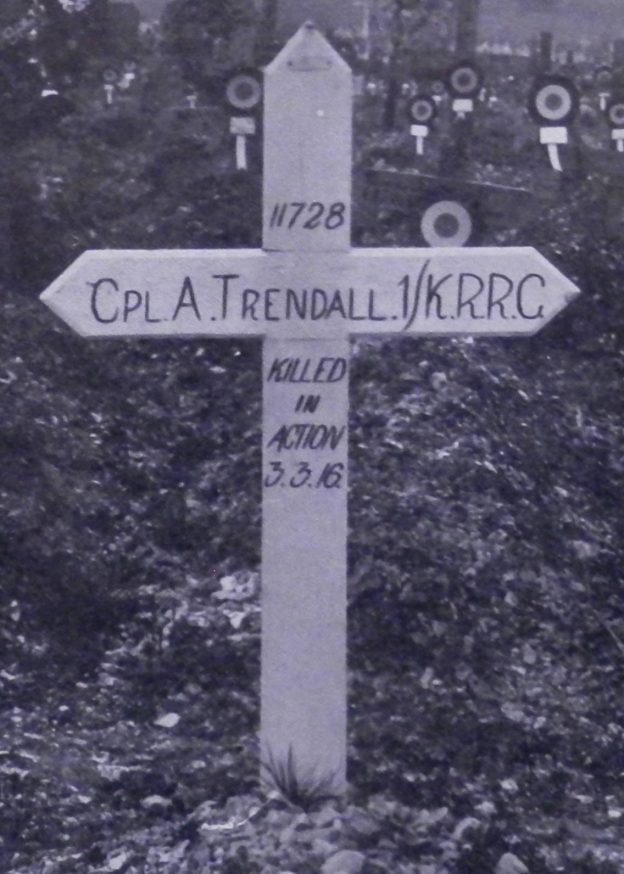 Pas de Calais, France, II.H.21.
Pas de Calais, France, II.H.21.
Born: c1896 Penn.
Engineering apprentice.
Worked for uncle:
J T Bateman, Wycombe Marsh.
Parents: John Trendell, & Kate née Plumridge,
The Larches, (now Keeper’s Cottage) Penn.
Note: Brother of Ernest Trendall.
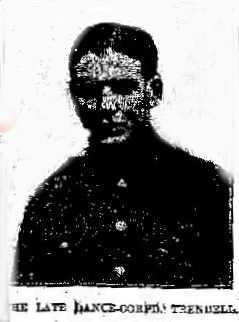 Ernest Albert TRENDELL, Lance Corporal, 17110,
Ernest Albert TRENDELL, Lance Corporal, 17110,
Hampshire Regiment, 1st Battalion
Age: 18, Died: 1 July 1916, Killed in action,
no known grave. Thiepval Memorial, Somme, France,
Pier & Face 7C & 7B.
Parents: John Trendell, & Kate Trendell,
The Larches, (now Keeper’s Cottage), Penn.
Note: Formerly: 17479 Oxford & Bucks Light Infantry.
Brother of Alfred Trendall.
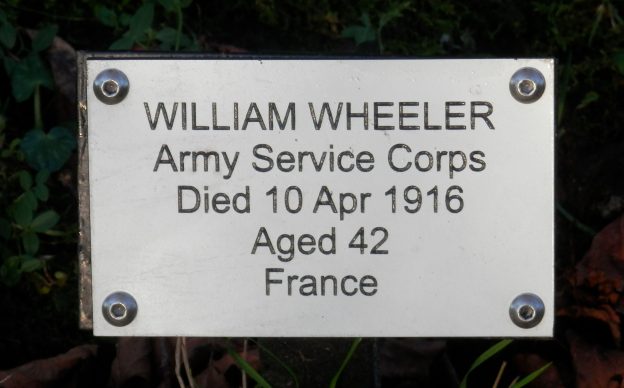 William Wingrove WHEELER, Private, R4/067820,
William Wingrove WHEELER, Private, R4/067820,
Royal Army Service Corps, 4th Base Remount Depot.
Age: 42, Died: 10 April 1916, France & Flanders.
Boulogne Eastern Cemetery, Pas de Calais, France, VIII.A. 90.
Baptism 16 May 1875, Tylers Green.
Pre-war occupation, bricklayer.
Parents: George Wheeler, Builder of St. Margaret’s Church,
& Margaret Channer, Homeleigh, Tyler’s Green.
Wife: Leah Wheeler née Fisher, four daughters, Rose Cottage, Penn
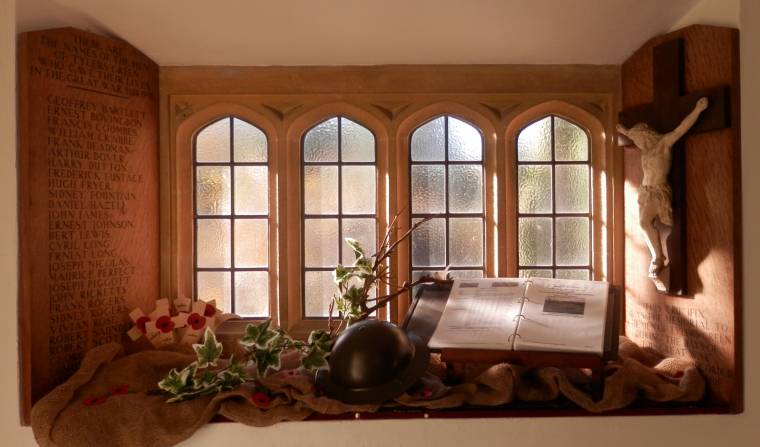
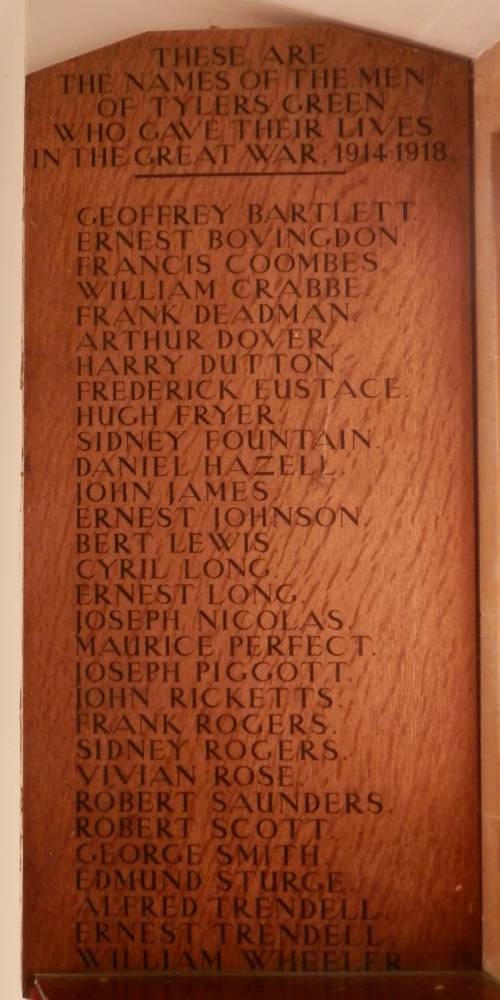
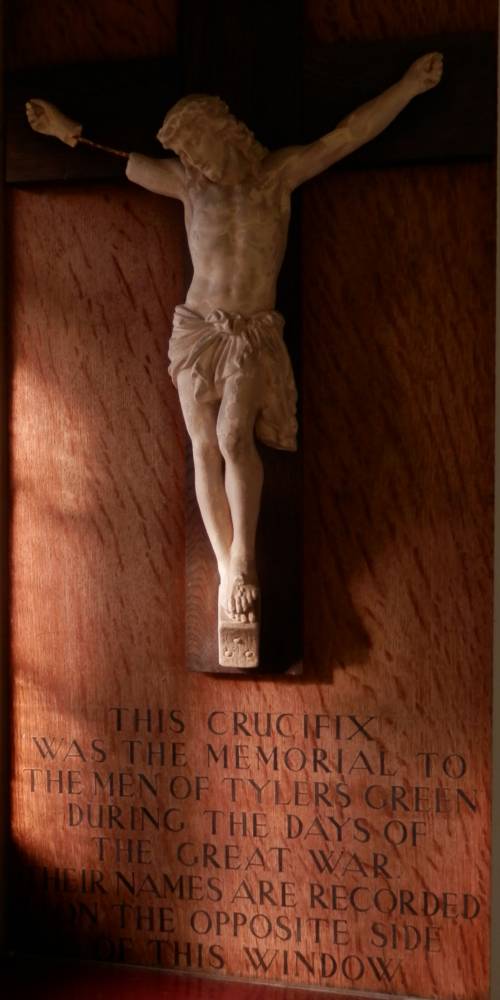
The information above is taken from a number of sources: June and Peter Underwood’s comprehensive website Buckinghamshire Remembers, the book ‘Penn & Tylers Green in the Great War and the Men Who Did Not Return‘, by Ron Saunders, published by the Penn & Tylers Green Residents Society. The book can be purchased here. Additional detail from the Commonwealth War Graves Commission website. Forces.net has a ‘long read’ of additional information about the memorial trees and the men named on them.
Holy Trinity, Penn War Memorials can be found on the pennchurch.uk website.

